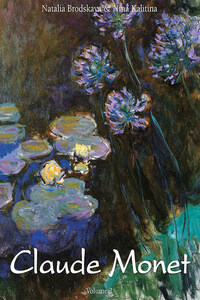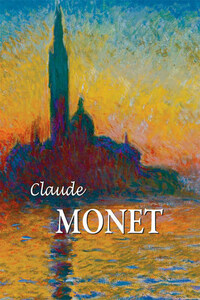Layout:
Baseline Co. Ltd
61A-63A Vo Van Tan Street
4>th Floor
District 3, Ho Chi Minh City
Vietnam
© Confidential Concepts, worldwide, USA
© Parkstone Press International, New York, USA
Image-Bar www.image-bar.com
All rights reserved.
No part of this publication may be reproduced or adapted without the permission of the copyright holder, throughout the world. Unless otherwise specified, copyright on the works reproduced lies with the respective photographers, artists, heirs or estates. Despite intensive research, it has not always been possible to establish copyright ownership. Where this is the case, we would appreciate notification.
* * *
Impression, Sunrise, 1837.
Oil on canvas, 48 × 63 cm. Musée Marmottan Monet, Paris.
Pierre-Auguste Renoir, Portrait of Claude Monet, 1875.
Oil on canvas, 84 × 60.5 cm. Musée d’Orsay, Paris.
Impression, Sunrise (1873, Musée Marmottan Monet, Paris) was the prescient title of one of Claude Monet’s paintings shown in 1874 in the first exhibition of the Impressionists, or as they called themselves then, the Société anonyme des artistes, peintres, sculpteurs, graveurs, etc. (The Anonymous Society of Artist, Painters, Sculptors, and Engravers). Monet had gone painting in his childhood hometown of Le Havre to prepare for the event, eventually selecting his best Havre landscapes for display. Edmond Renoir, journalist brother of Renoir the painter, compiled the catalogue. He criticised Monet for the uniform titles of his works, for the painter had not come up with anything more interesting than View of Le Havre. Among these Havre landscapes was a canvas painted in the early morning depicting a blue fog that seemed to transform the shapes of yachts into ghostly apparitions. The painting also depicted smaller boats gliding over the water in black silhouette, and above the horizon the flat, orange disk of the sun, its first rays casting an orange path across the sea. It was more like a rapid study than a painting, a spontaneous sketch done in oils – what better way to seize the fleeting moment when sea and sky coalesce before the blinding light of day? View of Le Havre was obviously an inappropriate title for this particular painting, as Le Havre was nowhere to be seen. “Write Impression,” Monet told Edmond Renoir, and in that moment began the story of Impressionism.
On 25 April 1874, the art critic Louis Leroy published a satirical piece in the journal Charivari that described a visit to the exhibition by an official artist. As he moves from one painting to the next, the artist slowly goes insane. He mistakes the surface of a painting by Camille Pissarro, depicting a ploughed field, for shavings from an artist’s palette carelessly deposited onto a soiled canvas. When looking at the painting he is unable to tell top from bottom, or one side from the other. He is horrified by Monet’s landscape entitled Boulevard des Capucines. Indeed, in Leroy’s satire, it is Monet’s work that pushes the academician over the edge. Stopping in front of one of the Havre landscapes, he asks what Impression, Sunrise depicts. “Impression, of course,” mutters the academician. “I said so myself, too, because I am so impressed, there must be some impression in here… and what freedom, what technical ease!” At which point he begins to dance a jig in front of the paintings, exclaiming: “Hey! Ho! I’m a walking impression, I’m an avenging palette knife”. Leroy called his article, “The Exhibition of the Impressionists”. With typical French finesse, he had adroitly coined a new word from the painting’s title, a word so fitting that it was destined to remain forever in the vocabulary of the history of art. Responding to questions from a journalist in 1880, Monet said: “I’m the one who came up with the word, or who at least, through a painting that I had exhibited, provided some reporter from Le Figaro the opportunity to write that scathing article. It was a big hit, as you know.”

Pierre-Auguste Renoir, Claude Monet, 1872.
Oil on canvas, 65 × 50 cm.
National Gallery of Art, Washington, D.C.
Gustave Geffroy, the friend and biographer of Claude Monet, reproduced two portraits of the artist in his monograph. In the first, painted by an artist of no distinction, Monet is eighteen years of age. A dark-haired young man in a striped shirt, he is perched astride a chair with his arms folded across its back.
His pose suggests an impulsive and lively character; his face, framed by shoulder-length hair, shows both unease in the eyes and a strong will in the line of the mouth and the chin.
Geffroy begins the second part of his book with a photographic portrait of Monet at the age of eighty-two.
A stocky old man with a thick, white beard stands confidently, his feet set wide apart; calm and wise, Monet knows the value of things and believes only in the undying power of art. Not by chance has he chosen to pose with a palette in his hand in front of a panel from the Water Lilies series.
Numerous portraits of Monet have survived – self-portraits, the works of his friends (Manet and Renoir among others), photographs by Carjat and Nadar – all of them reproducing his features at various stages in his life.










